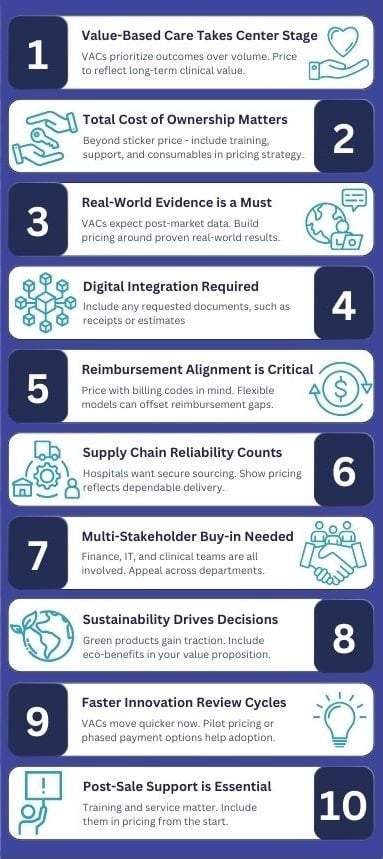Switzerland (Head Quarters)
IDR Medical Switzerland
Austrasse 95, CH-4051 Basel, Switzerland
T:
+41 (0) 61 535 1109
UK
IDR Medical UK
Unit 104 Eagle Tower, Eagle Tower
Montpellier Drive, Cheltenham, GL50 1TA
T:
+44 (0) 1242 696 790
USA
IDR Medical North America
225 Franklin Street, 26th Floor
Boston, Massachusetts 02110, USA
T:
+1 (0) 617.275.4465

10 Key Changes in VAC Decisions That Shape Pricing Strategies
The Value Analysis Committee (VAC) plays a critical role in evaluating and approving new medical technologies for hospital adoption.
Over the past five years, Value Analysis Committees (VACs) have significantly evolved in how they assess and approve new medical technologies. Driven by changing healthcare policies, cost pressures, and digital innovation, these shifts are redefining the path to adoption. To succeed, medical device manufacturers must understand and adapt to these evolving priorities.
In this article, we outline 10 of the most impactful changes in VAC decision-making and what they mean for your pricing strategy.

1. Increased Focus on Value-Based Care
- Value-based care is the priority. VACs emphasize patient outcomes over procedure volume.
- Pricing strategies should emphasize long-term value, such as reducing complications, hospital stays, or readmissions.
- Consider risk-sharing or performance-based pricing models to align with value-based reimbursement structures.
2. Greater Scrutiny on Total Cost of Ownership (TCO)
- Decision-making has moved beyond initial purchase price to assess long-term costs, including maintenance, training, and consumables.
- A transparent pricing strategy should outline all associated costs and offer bundled pricing or service agreements to address concerns about hidden expenses.
- Subscription or leasing models may appeal to hospitals looking to manage long-term costs more predictably.
3. Stronger Emphasis on Real-World Evidence (RWE)
- Clinical trial data alone is no longer sufficient, VACs demand real-world usage data demonstrating effectiveness in practical settings.
- A pricing strategy should factor in the cost of post-market studies and real-world validation to strengthen the business case for adoption.
- Offering tiered pricing based on real-world outcomes can help align with hospital priorities.
4. Alignment with Digital & AI-Driven Healthcare Solutions
- Hospitals are integrating more AI-driven decision support tools, and VACs expect new technologies to be compatible with these systems.
- Pricing should reflect interoperability and added value from AI-driven efficiencies, potentially justifying a premium price.
- Consider offering modular pricing, where AI-enabled features are available as add-ons.
5. Heightened Importance of Reimbursement & Payer Alignment
- VACs are increasingly focused on whether a technology is reimbursable and how it aligns with payer strategies.
- Pricing should be structured with reimbursement pathways in mind, ensuring hospitals can recover costs through existing billing codes.
- If reimbursement is uncertain, offering alternative financing options or flexible payment models can reduce adoption barriers.
6. More Stringent Supply Chain & Procurement Considerations
- Supply chain disruptions from global events have led VACs to place greater emphasis on supply stability, vendor reliability, and sourcing strategies.
- Competitive pricing should account for supply chain resilience, ensuring sustainable production and reliable distribution.
- Volume-based discounts or regional supply contracts can enhance hospital confidence in long-term availability.
7. Stronger Cross-Disciplinary Collaboration in Decision-Making
- VACs now include broader representation from IT, finance, infection control, and even patient advocacy groups.
- Pricing strategies should be framed to appeal to both clinical and financial decision-makers, ensuring a balanced value proposition.
- Flexible pricing models that account for different departmental needs can make a solution more attractive across stakeholder groups.
8. Environmental & Sustainability Considerations
- Hospitals are under increasing pressure to meet sustainability goals, making eco-friendly and energy-efficient technologies more appealing.
- Pricing strategies should highlight sustainability benefits, such as reduced waste, energy efficiency, or end-of-life recycling, as value-adds that support hospital ESG goals.
- Consider offering sustainability incentives, such as trade-in programs or discounts for environmentally responsible hospitals.
9. Accelerated Evaluation Processes for Innovative Technologies
- Due to rapid advancements in medical technology, VACs have adapted their processes to evaluate innovations more efficiently.
- A pricing strategy should be prepared for rapid deployment models, such as pilot programs or limited-time introductory pricing.
- Providing financial flexibility through phased payments can help hospitals transition to innovative technologies more easily.
10. Demand for Stronger Post-Implementation Support
- VACs now expect robust post-sale support, including training, troubleshooting, and long-term service commitments.
- Pricing should include post-implementation services as part of a comprehensive package rather than an afterthought.
- Consider subscription-based service models or value-added maintenance contracts to enhance long-term customer relationships.
As Value Analysis Committees continue to evolve, so must the strategies used to gain their approval. By aligning pricing with long-term value, reimbursement models, and operational priorities, manufacturers can not only improve their chances of adoption, but also build stronger, more strategic partnerships with provider organizations.
Success in this landscape will belong to companies that price with insight, flexibility, and a deep understanding of the hospital decision-making process.
Support Your VAC Strategy with Insight-Driven Research
Effectively engaging Value Analysis Committees requires more than a compelling product—it demands a clear, evidence-based narrative tailored to evolving decision-making priorities.
At IDR Medical, we specialize in delivering high-impact research that helps MedTech companies craft messages that resonate with VACs. From real-world evidence generation to stakeholder perception studies, our insights help you:
- Understand key decision drivers across clinical, financial, and operational stakeholders
- Build persuasive, data-backed value propositions aligned with VAC expectations
- Refine communication strategies to address objections and accelerate approval
- Test messaging, pricing models, and positioning before market launch
Whether you're preparing for a VAC presentation or shaping your go-to-market strategy, our research ensures you're speaking the language that matters most.
Contact us today to learn how IDR Medical can strengthen your market access strategy.

